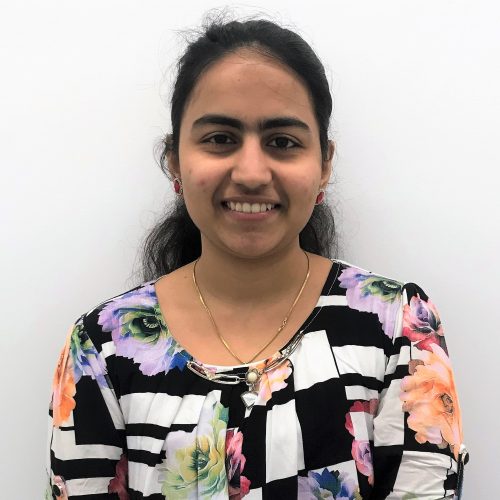The Future — and Its Faculty — Are Female
NYU Tandon Student Wins Prestigious Schlumberger Faculty for the Future Fellowship
When Haripriya Kannan was growing up in Neyveli — a town in the Indian state of Tamil Nadu best known for its reserves of a form of coal known as lignite — she gained a visceral understanding of how people’s health was affected by pollution. Determined to get an education that would allow her to one day find sources of cleaner energy, she studied hard enough to become one of the few girls from her hometown to pass the rigorous engineering exam required to attend a top government school.
 Accepted to the highly competitive National Institute of Technology, in Trichy, she earned an undergraduate degree in Metallurgical and Materials Engineering — a field that she acknowledges is an unusual one for Indian women, who are sometimes discouraged by tradition-bound parents from pursuing male-dominated careers. During her senior year Kannan was one of only a dozen Indian students to serve as an Indian National Academy of Engineering (INAE) Student Member, and in that capacity she gave a presentation to a distinguished panel of scientists, engineers, and academicians on the importance of student research to nation-building and ways to increase the participation of women in the STEM fields: she had been dismayed to find that although the literacy rates for girls in her native country were gradually rising, that good news was offset by the fact that many women ultimately dropped out to become homemakers. And although she herself had not suffered gender discrimination, she could not help but notice that only one in 12 faculty members at her school was female.
Accepted to the highly competitive National Institute of Technology, in Trichy, she earned an undergraduate degree in Metallurgical and Materials Engineering — a field that she acknowledges is an unusual one for Indian women, who are sometimes discouraged by tradition-bound parents from pursuing male-dominated careers. During her senior year Kannan was one of only a dozen Indian students to serve as an Indian National Academy of Engineering (INAE) Student Member, and in that capacity she gave a presentation to a distinguished panel of scientists, engineers, and academicians on the importance of student research to nation-building and ways to increase the participation of women in the STEM fields: she had been dismayed to find that although the literacy rates for girls in her native country were gradually rising, that good news was offset by the fact that many women ultimately dropped out to become homemakers. And although she herself had not suffered gender discrimination, she could not help but notice that only one in 12 faculty members at her school was female.
During her undergraduate years Kannan, who focused her research on increasing thermoelectric materials efficiency, had won a series of scholarships, including the Central Government Ministry of Steel Scholarship and the DAAD-Wise Fellowship, which allowed her the financial freedom to consider graduate school. (Her parents, plagued by fears of debt, had lobbied for her to enter directly into the work world.) Admitted to NYU Tandon, she traveled from Tamil Nadu to Brooklyn, where she began studying with Assistant Professor of Chemical and Biomolecular Engineering Ayaskanta Sahu and researching perovskites, a new class of material for efficient energy conversion.
Specifically, she is working on the design of next-generation x-ray detectors that utilize perovskites and that she foresees being used, ultimately, for mammography to detect early-stage breast cancer. Because nearly 300,000 new cases of breast cancer are currently being reported every year in the U.S. alone, the successful implementation of the technology would drastically improve the chances of administering timely therapy and the survival of larger numbers of women throughout the world.
One day, Sahu, whose Tandon research group is 80 percent female, came across word of an intriguing fellowship opportunity. Schlumberger, a global provider of technology for the oil and gas industry, had made it a corporate mission to support STEM education, and among the initiatives conducted by its philanthropic foundation was the Schlumberger Faculty for the Future Fellowship — an elite competition launched in 2004 and aimed at aspiring female scientists from developing nations. Its arduous selection process involved five rounds, during which each applicant’s research proposal and personal statement would be scrutinized before they were subjected to a series of phone interviews.
The thoroughness of the process meant that very few applicants would ultimately be successful — since the competition’s inception, fewer than 700 have been chosen — but Sahu felt confident that his student had a good chance and encouraged her to apply.
His confidence was not misplaced: Kannan became one of only 50 applicants from around the globe to be awarded a 2018-19 fellowship from Schlumberger.
Among the conditions of the generous fellowship is that recipients return to their native countries after earning their doctoral degrees to contribute to economic, social, and technological advancement; strengthen the STEM teaching and research faculties of their home institutions; and pursue positions in the public sector where their newly acquired technical and scientific skills can help provide evidence-based support for STEM policymaking. The hope is that they will become powerful role models and help to inspire other girls and women to pursue scientific careers.
Pointing out that the student body at the National Institute of Technology, in Trichy, contains only 4 percent women, Kannan said, “I would be happy to be a seed in a chain reaction of contributing to and encouraging women in technology.”

